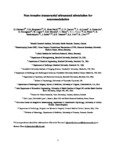Non-invasive transcranial ultrasound stimulation for neuromodulation
| dc.contributor.author | Darmani, G | |
| dc.contributor.author | Bergmann, TO | |
| dc.contributor.author | Butts Pauly, K | |
| dc.contributor.author | Caskey, CF | |
| dc.contributor.author | de Lecea, L | |
| dc.contributor.author | Fomenko, A | |
| dc.contributor.author | Fouragnan, Elsa | |
| dc.contributor.author | Legon, W | |
| dc.contributor.author | Murphy, KR | |
| dc.contributor.author | Nandi, T | |
| dc.contributor.author | Phipps, MA | |
| dc.contributor.author | Pinton, G | |
| dc.contributor.author | Ramezanpour, H | |
| dc.contributor.author | Sallet, J | |
| dc.contributor.author | Yaakub, Siti Nurbaya | |
| dc.contributor.author | Yoo, SS | |
| dc.contributor.author | Chen, R | |
| dc.date.accessioned | 2022-01-14T20:24:27Z | |
| dc.date.available | 2022-01-14T20:24:27Z | |
| dc.date.issued | 2022-03 | |
| dc.identifier.issn | 1388-2457 | |
| dc.identifier.issn | 1872-8952 | |
| dc.identifier.uri | http://hdl.handle.net/10026.1/18561 | |
| dc.description.abstract |
Transcranial ultrasound stimulation (TUS) holds great potential as a tool to alter neural circuits non-invasively in both animals and humans. In contrast to established non-invasive brain stimulation methods, ultrasonic waves can be focused on both cortical and deep brain targets with the unprecedented spatial resolution as small as a few cubic millimeters. This focusing allows exclusive targeting of small subcortical structures, previously accessible only by invasive deep brain stimulation devices. The neuromodulatory effects of TUS are likely derived from the kinetic interaction of the ultrasound waves with neuronal membranes and their constitutive mechanosensitive ion channels, to produce short term and long-lasting changes in neuronal excitability and spontaneous firing rate. After decades of mechanistic and safety investigation, the technique has finally come of age, and an increasing number of human TUS studies are expected. Given its excellent compatibility with non-invasive brain mapping techniques, such as electroencephalography (EEG) and functional magnetic resonance imaging (fMRI), as well as neuromodulatory techniques, such as transcranial magnetic stimulation (TMS), systemic TUS effects can readily be assessed in both basic and clinical research. In this review, we present the fundamentals of TUS for a broader audience. We provide up-to-date information on the physical and neurophysiological mechanisms of TUS, available readouts for its neural and behavioral effects, insights gained from animal models and human studies, potential clinical applications, and safety considerations. Moreover, we discuss the indirect effects of TUS on the nervous system through peripheral co-stimulation and how these confounding factors can be mitigated by proper control conditions. | |
| dc.format.extent | 51-73 | |
| dc.format.medium | Print-Electronic | |
| dc.language | en | |
| dc.language.iso | en | |
| dc.publisher | Elsevier BV | |
| dc.subject | Transcranial ultrasound stimulation | |
| dc.subject | Neuromodulation | |
| dc.subject | Plasticity | |
| dc.subject | Non-invasive brain stimulation | |
| dc.title | Non-invasive transcranial ultrasound stimulation for neuromodulation | |
| dc.type | journal-article | |
| dc.type | Journal Article | |
| dc.type | Research Support, N.I.H., Extramural | |
| dc.type | Research Support, Non-U.S. Gov't | |
| dc.type | Review | |
| plymouth.author-url | https://www.webofscience.com/api/gateway?GWVersion=2&SrcApp=PARTNER_APP&SrcAuth=LinksAMR&KeyUT=WOS:000773488000007&DestLinkType=FullRecord&DestApp=ALL_WOS&UsrCustomerID=11bb513d99f797142bcfeffcc58ea008 | |
| plymouth.volume | 135 | |
| plymouth.publication-status | Published | |
| plymouth.journal | Clinical Neurophysiology | |
| dc.identifier.doi | 10.1016/j.clinph.2021.12.010 | |
| plymouth.organisational-group | /Plymouth | |
| plymouth.organisational-group | /Plymouth/Faculty of Health | |
| plymouth.organisational-group | /Plymouth/Faculty of Health/School of Psychology | |
| plymouth.organisational-group | /Plymouth/REF 2021 Researchers by UoA | |
| plymouth.organisational-group | /Plymouth/REF 2021 Researchers by UoA/UoA04 Psychology, Psychiatry and Neuroscience | |
| plymouth.organisational-group | /Plymouth/Users by role | |
| plymouth.organisational-group | /Plymouth/Users by role/Academics | |
| plymouth.organisational-group | /Plymouth/Users by role/Researchers in ResearchFish submission | |
| dc.publisher.place | Netherlands | |
| dcterms.dateAccepted | 2021-12-22 | |
| dc.rights.embargodate | 2022-12-31 | |
| dc.identifier.eissn | 1872-8952 | |
| rioxxterms.funder | Medical Research Council | |
| rioxxterms.identifier.project | Mapping the neural basis of credit assignment for a new targeted intervention in addiction | |
| rioxxterms.versionofrecord | 10.1016/j.clinph.2021.12.010 | |
| rioxxterms.licenseref.uri | http://www.rioxx.net/licenses/all-rights-reserved | |
| rioxxterms.licenseref.startdate | 2022-03 | |
| rioxxterms.type | Journal Article/Review | |
| plymouth.funder | Mapping the neural basis of credit assignment for a new targeted intervention in addiction::Medical Research Council |


